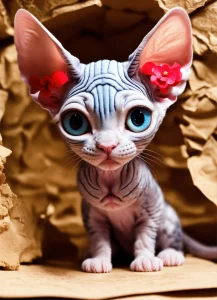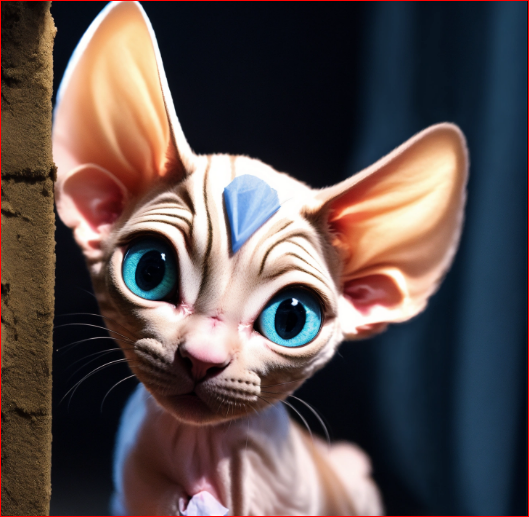Hairless cats definitely stand out. Their wrinkled skin, big ears, and playful personalities make them a fascinating choice for cat lovers. But what is it about hairless cats that captures our hearts? Let’s dive into the world of these intriguing creatures and discover why they are more than just cute—they’re genuinely special.
What Makes Hairless Cats So Unique?
Origins and Evolution
Hairless cats, often called sphynx cats, are a breed that’s instantly recognizable due to their lack of fur. This unique trait is not just for show; it’s the result of a natural genetic mutation. Unlike other cats, hairless cats have a smooth, almost velvety skin that gives them a distinctive appearance. Their lack of fur reveals the full extent of their muscular bodies, and they often have a playful, lively demeanor that matches their unusual look.

The History Behind Hairless Cats
The sphynx cat’s history is as unique as its appearance. This breed originated in Canada in the 1960s when a domestic cat gave birth to a hairless kitten. Breeders saw potential in this genetic anomaly and began developing the breed. Interestingly, hairless cats are not a completely new phenomenon; historical records suggest that hairless cats appeared in ancient civilizations, although they were not as well-documented or as widely recognized as modern sphynx cats.
How Hairless Cats Differ from Other Breeds
Physical Characteristics
Hairless cats are characterized by their lack of a traditional fur coat. Instead of fur, they have a thin layer of peach-fuzz-like down that gives them a soft, suede-like texture. Their skin can vary in color, ranging from light pink to darker hues, and they often have a few visible wrinkles. Unlike other cats, hairless cats do not have the usual protective layer of fur, so they can be more sensitive to temperature changes.
Temperament and Behavior
One of the most endearing traits of hairless cats is their lively personality. These cats are known for being incredibly affectionate and playful. They love to interact with their human companions and are often described as “lap cats” because they enjoy snuggling up for warmth. Their energy levels are high, and they require plenty of mental and physical stimulation to keep them happy.
Care and Maintenance of Hairless Cats
Grooming Needs
While hairless cats don’t require regular brushing like their fur-coated counterparts, they do need special care. Their lack of fur means their skin can accumulate oils and dirt more quickly. Regular bathing is essential to keep their skin clean and healthy. Use a gentle, cat-safe shampoo and make sure to dry them thoroughly to prevent any skin issues.
Health Considerations
Hairless cats are generally healthy, but their unique physiology does come with some specific health considerations. They are more susceptible to temperature extremes, so keeping them in a well-regulated environment is crucial. Regular vet check-ups are important to monitor their skin health and to ensure they are free from common feline ailments.
Why Hairless Cats Are So Cute
Their Unique Appearance
Let’s face it: there’s something undeniably charming about a cat with no fur. The sphynx’s large ears, expressive eyes, and distinctive wrinkles make them visually captivating. Their appearance is so different from the norm that they often attract attention and admiration from those who encounter them.
Personality Traits
Beyond their looks, hairless cats are known for their endearing personality traits. They are affectionate, social, and curious—traits that make them great companions. Their playful antics and love for attention can bring joy and laughter to any household.
The Popularity of Hairless Cats
In Pop Culture
Hairless cats have made quite an impact in pop culture. From TV shows to movies, these unique felines have been featured in various forms of media. Their striking appearance and charming personalities have captured the imagination of many, making them popular subjects for artistic and entertainment purposes.
Adopting a Hairless Cat
If you’re thinking about adopting a hairless cat, there are a few things to consider. First, ensure you’re prepared for their specific care needs, including regular bathing and maintaining a comfortable living environment. Additionally, hairless cats are social creatures that thrive on human interaction, so be ready to provide them with plenty of love and attention.
Conclusion
In conclusion, hairless cats are more than just a unique appearance—they are affectionate, playful companions that bring a lot of joy to their owners. Their distinctive look and lively personality make them a standout choice for pet lovers looking for something a little different. Whether you’re drawn to their smooth skin or their engaging nature, hairless cats offer a blend of cuteness and charm that’s hard to resist.
FAQs
1. Are hairless cats hypoallergenic?
Hairless cats are not completely hypoallergenic, but they may produce fewer allergens than other breeds due to their lack of fur. However, they still require regular grooming to manage skin oils and allergens.
2. Do hairless cats get cold easily?
Yes, hairless cats can get cold more easily than fur-covered cats. It’s important to keep them in a warm environment and provide them with cozy blankets or sweaters if needed.
3. How often should I bathe my hairless cat?
Hairless cats should be bathed regularly, about once a week or as needed, to remove excess oils and dirt from their skin.
4. What is the lifespan of a hairless cat?
Hairless cats typically have a lifespan of 12 to 15 years, though with proper care, some can live even longer.
5. Can hairless cats go outside?
Hairless cats can go outside, but it’s important to ensure they are protected from extreme temperatures and sun exposure. It’s often best to keep them indoors or in a controlled outdoor environment.

